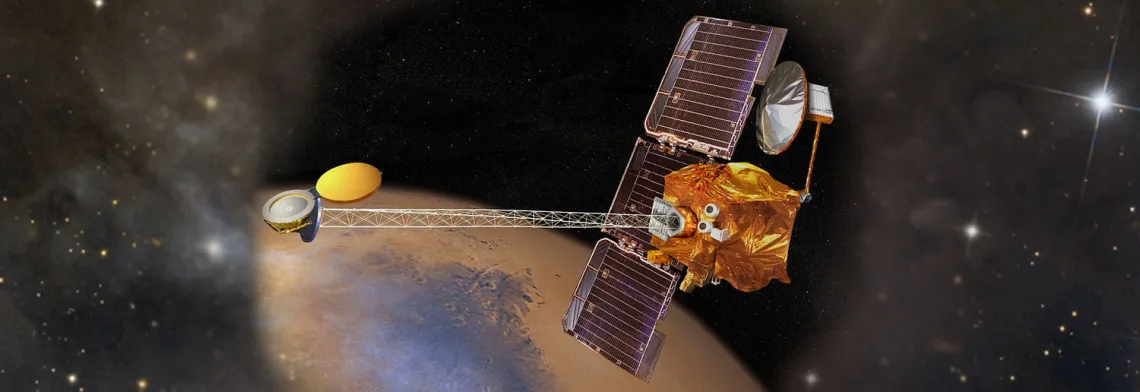One Man’s Mission to Mars, 30 Years in the Making
Bill Boynton has contributed to 10 NASA missions in his lifetime, including OSIRIS-REx, which began its journey to the asteroid Bennu last month. But this month, Boynton can’t help but think about Mars.

Before his life's work got to Mars, Bill Boynton toiled, witnessed an explosion, and mourned a loss. It's been 15 years since Mars Odyssey arrived at the red planet, and now Boynton talks about how it all came to be.
Mars Observer
In the 1980s, "space science" was just 11.5 percent of NASA's budget, and planetary science was an even smaller slice of that. The saying was "Better, faster, cheaper." (Boynton says "Pick two.") Out of this climate of tightfistedness, the Planetary Observer line was born. Planetary Observers were to be built on the cheap, using common technology from old spacecraft. The first and only observer, the Mars Observer, launched in 1992, a whole 17 years after the United States' last mission to Mars. The Mars Observer was the culmination of eight years of work and $813 million – the original budget allocated $212 million – and it exploded just two days before it was due to arrive at Mars in 1993.
Boynton, professor of planetary sciences at the University of Arizona, was the lead scientist for one of the spacecraft's seven instruments: the gamma ray spectrometer, or GRS. The explosion, caused by a leaky valve filled with pressurized helium and fuel, was tough on him.
"When the thing blew up, it was devastating," he says. "It was like there had been a death in the family." His colleagues didn't know the right words to say when they'd crossed paths in the elevator, and his department head told him, "'Bill, we'll probably need to call off the celebrations.'" They had planned a big party for when the Observer entered orbit. Boynton proposed, instead, a wake, which felt truly appropriate for the death of the spacecraft.
At the wake, he says, "I gave a talk about what the mission would've been like, what we did learn from it, and explained why it was not a waste of millions of dollars." It was cathartic. It was reassuring. It was time to go back to work.
At first, the Mars Observer team planned to rebuild the same observer using parts set aside for such an event, until the then head of NASA, Daniel Goldin, suggested something drastically different. Goldin proposed building three new spacecraft from scratch, each only carrying two or three instruments. The idea was met with skepticism. "I think most of us were thinking it was stupid," says Boynton. "But in the end, it turned out to be a really good idea."
The Mars Odyssey
And just like that, the Mars Observer mission turned into the Mars Odyssey. The unmanned Mars Odyssey launched in 2001, in search of evidence of water and ice, new information about the planet's geology, and about its potential ability to sustain life. Aboard the spacecraft were three new scientific instruments, including Boynton’s gamma ray spectrometer, designed and built at the University of Arizona.
Mars Odyssey is a roughly seven-foot-tall spacecraft bearing a small fleet of solar panels that fan out like wings, and a 20-foot-long scaffold with the gamma ray spectrometer hanging off the end of it. This way, the spectrometer can detect gamma rays on the Martian surface without muddying the signal with its own electromagnetic radiation. The GRS measures gamma rays emitted by the surface of Mars and, in turn, calculates the abundance of chemical elements across the planet's surface.
Fifteen Years of Scientific Discovery
Since arriving at Mars 15 years ago on Oct. 24, the Mars Odyssey has mapped the surface of Mars, detected its elemental composition – Mars is rich in elements like silicon, aluminum, calcium, uranium, and chlorine – communicated with rovers to relay information, and, perhaps most remarkably, discovered large amounts of ice on Mars, covering its polar regions.
"The ice is buried a few inches beneath the surface, but hydrogen gives off a gamma ray, so we found it," says Boynton.
The mission was originally planned to last for two to three years, but remains operational, orbiting Mars. Eventually – soon, guesses Boynton – the spacecraft will give out and Mars Odyssey will come to an end, but Boynton will keep busy.
As a mission instrument scientist for the recently launched OSIRIS-REx spacecraft, Boynton and colleagues will now uncover new information about the origins and formation of our solar system.
Realizing he's dedicated more than 30 years of his life to ten different NASA missions, Boynton says, "I'm sorry. It's hard not to tear up over some of these things," and wipes his cheek with a smile.

